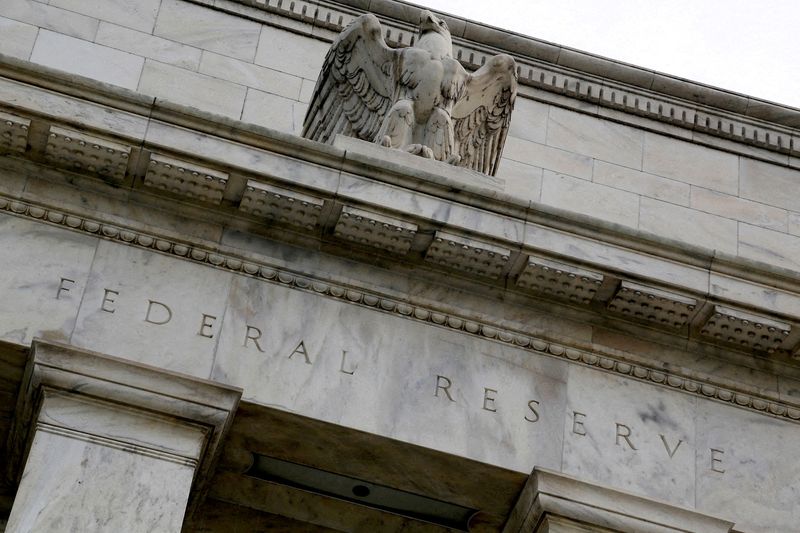
© Reuters. FILE PHOTO: An eagle tops the U.S. Federal Reserve building’s facade in Washington, July 31, 2013. REUTERS/Jonathan Ernst/File Photo
By Howard Schneider
WASHINGTON (Reuters) – The Federal Reserve is expected to raise its target interest rate by a quarter of a percentage point on Wednesday, setting aside the rapid hikes used last year to curb a surge in inflation in favor of a more stepwise hunt for a stopping point.
The expected increase would set the U.S. central bank’s benchmark overnight interest rate in the 4.50%-4.75% range, the highest since November 2007, when the economy was on the eve of what would prove to be a long and deep recession.
Policymakers hope to avoid that sort of outcome this time, and economic data since their last policy meeting in December generally has moved in the right direction: Inflation is slowing under the impact of higher interest rates and tighter financial conditions, while the economy continues to grow and create jobs.
The rate-setting Federal Open Market Committee is due to release its policy statement at 2 p.m. EST (1900 GMT). Fed Chair Jerome Powell is scheduled to hold a news conference half an hour later to elaborate on the decision.
“Recent events suggest that the coming year may be a notch less challenging than previously thought,” Nathan Sheets, chief global economist at Citi, wrote this week, noting that recession risks were easing on a global basis while U.S. data “pointed to continued growth, moderating inflation, and a slower pace of Fed rate hikes.”
Ahead of the Fed’s two-day meeting this week, the International Monetary Fund increased its outlook for a global economy that its officials said had proved “surprisingly resilient” in the face of monetary policy tightening and the ongoing war between Russia and Ukraine.
Caught flat-footed last year as inflation accelerated and threatened to prove far more persistent than anticipated, the Fed approved the fastest interest rate hikes since the 1980s. Starting with a quarter-percentage-point increase in March, the central bank by the summer was raising rates in increments of three-quarters of a percentage point, and all told moved the target policy rate up by 4.25 percentage points in just 10 months. It delivered a half-percentage-point hike at its Dec. 13-14 policy meeting.
The impact of the policy moves seems to be gaining steam. New data last week showed a key inflation measure slowed faster than expected in December, continuing a six-month downward trend. Growth in employment costs, closely watched as a possible indicator of future price increases, also slowed in the fourth quarter.
But the Fed’s preferred measure of inflation, the personal consumption expenditures price index, still rose at a 5% annual rate in December, down from a June high of nearly 7% but still more than double the central bank’s 2% inflation target.
New data released on Wednesday also showed one closely-watched measure of worker demand remained elevated, with the number of job openings in December rising back above 11 million to a level nearly double the number of people unemployed. The mismatch between the number of open jobs compared to the number of people looking for work is among the main economic imbalances the Fed feels may keep inflation elevated.
Policymakers are adamant they will not make what they consider to be the crucial error of pausing further rate hikes until they are convinced inflation is on a durable path back to the 2% goal.
‘HAWKISH RESOLVE’
Some analysts do expect the Fed to remove from its policy statement the current, open-ended promise of “ongoing increases” in interest rates, a phrase used since the central bank began its tightening cycle in March. Any new language, however, would still leave the door open for further increases depending on incoming economic data, particularly on inflation and jobs.
The expected move to 25-basis-point rate increases will be a “hawkish downshift,” BNP Paribas (OTC:) economists wrote ahead of this week’s policy meeting. “While we expect the Fed to downshift the pace of tightening to 25bp increments … we also anticipate a hawkish resolve … Policymakers are encouraged by recent developments, but appear to remain united in the need to ‘keep at it’ with respect to reducing inflation pressures.”
The Fed’s meeting this week, its first of 2023, will not include new economic forecasts from its policymakers, the most explicit way for them to signal where rates may be headed this year.
As of December, policymakers’ median forecast was for the Fed’s target interest rate to peak in a range between 5.00% and 5.25%, an outlook that would imply a pause in the policy tightening after two more quarter-percentage-point increases.
Traders of futures that settle to the Fed’s policy rate see the path somewhat differently, with the benchmark rate peaking in the 4.75%-5.00% range, and the central bank cutting that rate to around 4.4% by December.





